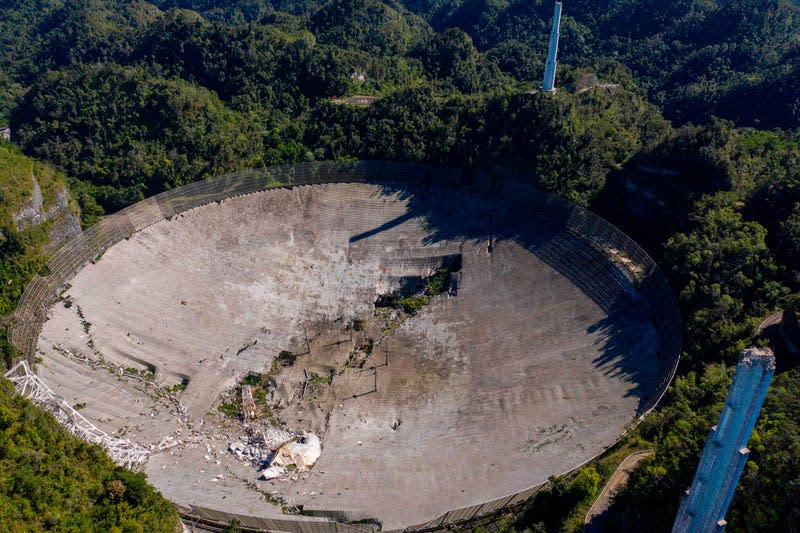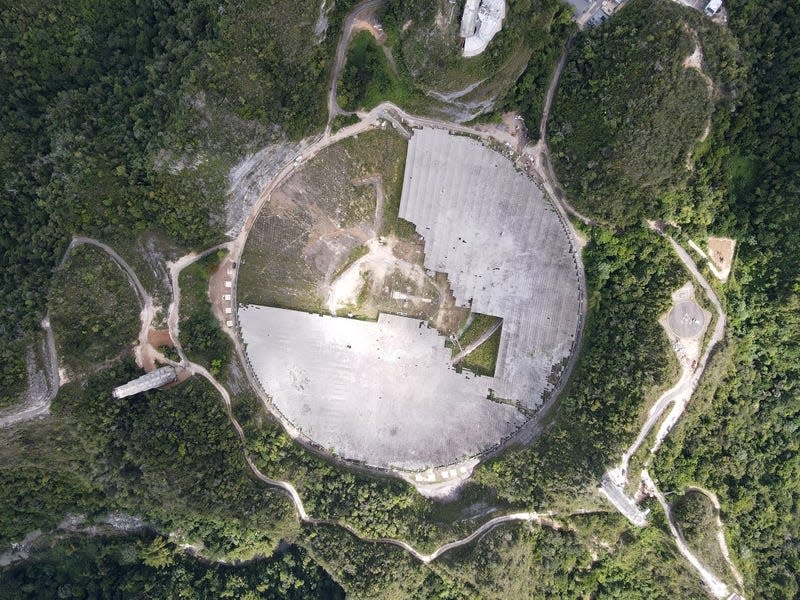Remembering the Arecibo Observatory Dish, Two Years After Its Collapse

The destroyed dish on the day of its collapse.
It happened in less than 10 seconds, two years ago today: The Arecibo Observatory’s 1,000-foot radio dish collapsed, eliminating one of the world’s most renowned sources of radio observations.
During its 57 years in operation in northern Puerto Rico, the radio telescope discovered new exoplanets, made radar maps of other worlds in our solar system, observed fast radio bursts, and supported the hunt for intelligent life beyond Earth.
Read more
Recently, Arecibo data was used in NASA’s daring (and successful!) DART mission, which saw a small spacecraft impact an asteroid, changing its trajectory. Its data also supported the OSIRIS-REx mission, in which a spacecraft grabbed a rock sample from a distant asteroid.
In the weeks preceding the collapse on December 1, 2020, cables suspending the observatory’s 900-ton platform above the dish had failed. Dramatic video shows the moment of the critical failure. Audio captured the screeches and groans of the massive structure as it ripped apart in mid-air and fell, crashing through the dish 450 feet below.
The site’s destruction wasn’t a total surprise. A couple of weeks before the collapse, two support cables fell onto the dish, damaging it. There was still hope that the structure could be stabilized, but then, the Nation Science Foundation announced that the dish would be demolished. But before that happened, the structure fell apart on its own.
“I’m still very sad about the loss of Arecibo. It was a great research facility for pulsar work—and many other things—and it is basically impossible to replace for U.S. researchers,” said Scott Ransom, a staff astronomer at the National Radio Astronomy Observatory, in an email to Gizmodo. Ransom’s work involves timing the flashes from pulsars, or rapidly spinning stellar remnants, to understand large-scale phenomena like the ripple of gravitational waves. That research involves radio wave data collected by Arecibo.
The collapse “was an even bigger loss for the island of Puerto Rico, though,” Ransom added. “A world-class facility right in their backyard that inspired so many Puerto Ricans that they can also do front-line scientific research.”
But this October, a new path was charted for the Arecibo facility. The National Science Foundation said that the site of the destroyed telescope would become an education center, set to open in 2023. The NSF is soliciting proposals for the education center but has not announced any plans to put more active scientific infrastructure on the site.

The telescope dish in September 2021.
“On the one hand, I of course think that having additional STEM education opportunities is only going to be a positive development, and so I support initiatives like this one,” said Dom Pesce, an astrophysicist at Harvard University’s Black Hole Initiative, in an email to Gizmodo. “On the other hand, the proposed facility strikes me as a pale substitute for what was lost at Arecibo, and it does little to plug the scientific hole that the loss of the big dish left behind.”
“The Arecibo telescope was a cultural icon and an inspiration for many young scientists,” Pesce added. “Without an investment in new scientific infrastructure to replace it—which the NSF’s solicitation seems to explicitly exclude—then I can only imagine that the new educational facility will inevitably suffer from the very tangible difference between being able to say, ‘come here and look at all the cool science that we’re doing!’ versus ‘come here and look at all the cool science that we used to do!’”
The NSF solicitation (which can be read here) anticipates $5 million in funding, and proposals will be accepted through February 2023. The document didn’t detail any support funding for Arecibo’s other scientific operations, namely its lidar facility and its still-very-much-intact 36-foot radio telescope. But the radio astronomy community has been robbed of its crown jewel.
“The site is still suitable for science, though, so I’m hopeful that sometime in the future that it will be used for that again,” Ransom added. “One possibility would be for several dishes for the ngVLA, assuming that it will get built.”
What becomes of Arecibo—even what this proposed education center will look like—remains unclear. Radio astronomy is worse off for the dish’s unfortunate end, though the decades of data collected there will live on as a scientific resource for years to come.
More: Arecibo Observatory’s Greatest Triumphs
More from Gizmodo
Sign up for Gizmodo's Newsletter. For the latest news, Facebook, Twitter and Instagram.

